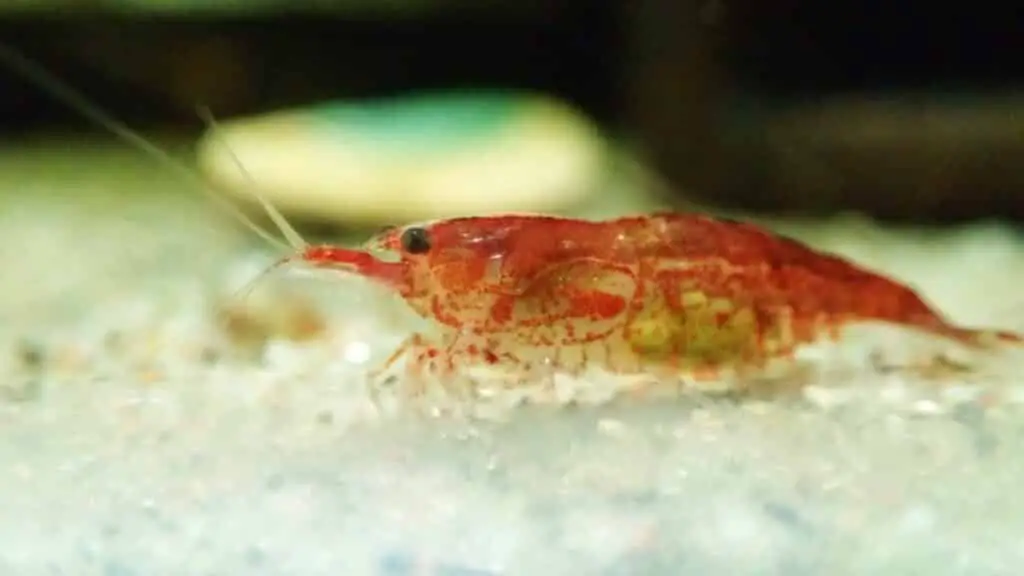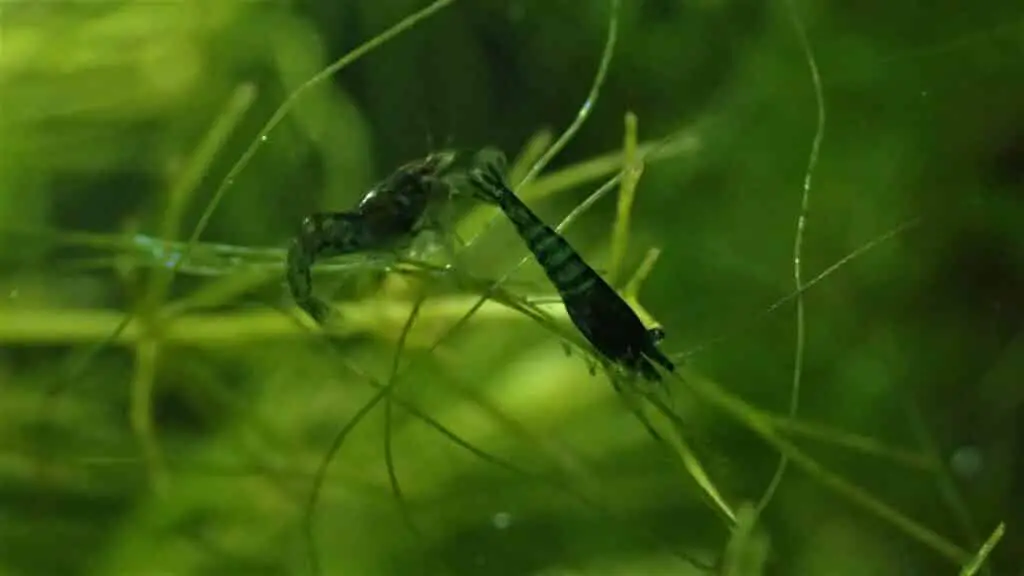Neocaridina davidi is a species of freshwater shrimp that has gained popularity among aquarists due to its vibrant coloration and easy care requirements. Originating from eastern China and northern Taiwan, these shrimp are now found in various parts of the world, including Japan, Hawaii, and in home aquariums globally. This blog post aims to provide a comprehensive guide on Neocaridina davidi, covering its characteristics, care requirements, breeding, and more.
| Classification | Name |
|---|---|
| Kingdom | Animalia |
| Phylum | Arthropoda |
| Subphylum | Crustacea |
| Class | Malacostraca |
| Order | Decapoda |
| Suborder | Pleocyemata |
| Infraorder | Caridea |
| Family | Atyidae |
| Genus | Neocaridina |
| Species | N. davidi |
| Binomial Name | Neocaridina davidi (Bouvier, 1904) |

About Neocaridina Davidi
Neocaridina davidi is a small, colorful freshwater shrimp that reaches about 4 centimeters in length when fully grown. They come in a wide range of colors, including red, yellow, orange, green, blue, violet, black, and more. However, the red morph, known as the cherry shrimp, is the most commonly sold. The color density of the shrimp
that reaches about 4 centimeters in length when fully grown. They come in a wide range of colors, including red, yellow, orange, green, blue, violet, black, and more. However, the red morph, known as the cherry shrimp, is the most commonly sold. The color density of the shrimp , which is dependent on breeding, determines their sale price and “quality.” However, this “quality” is purely aesthetic, as the size, behavior, and other characteristics of the shrimp are more or less equal across varieties.
, which is dependent on breeding, determines their sale price and “quality.” However, this “quality” is purely aesthetic, as the size, behavior, and other characteristics of the shrimp are more or less equal across varieties.
| Parameter | Value |
|---|---|
| Size | About 4 centimeters (1.6 inches) long when fully grown |
| Lifespan | 1-2 years |
| Color | Wide range including red, yellow, orange, green, blue, violet, black, etc. |
| Water pH | 6.5-8 |
| Water Temperature | 14–29 °C (57–84 °F), most comfortable at 22 °C (72 °F) |
| Diet | Omnivorous, primarily biofilm eaters |
| Breeding Age | 4-6 months old |
| Egg Incubation Period | 2-3 weeks |
| Aquarium Size | A few can be kept in a desktop aquarium of 4–8 litres, a setup of 40 L or more will allow for an active colony |
Tank Mates | Small, non-aggressive fish such as ember tetras, harlequin rasbora, neon tetra, cardinal tetra, dwarf corydoras, otocinclus catfish, dwarf gouramis, platy, and some species of killifish |
| Availability | Widely available in North America, Europe, Asia, and Australia |

 grazing
grazingHousing and Care
Neocaridina davidi shrimp are easy to care for in a home freshwater aquarium and breed well. They adapt to a wide range of water conditions and thrive in the same conditions as many common aquarium fish. A planted tank is most comfortable for the shrimp as the plants provide cover for adults and young, and also offer more surface area to grow biofilm for the shrimp to graze on. The shrimp spend a great deal of their time sitting on aquatic plants, when available, and hiding in them for protection, especially after molting.
What do neocaridina shrimp eat
Neocaridina davidi shrimp are omnivores and primarily biofilm eaters. They will eat any aquarium food, but some prefer algae wafers or sinking shrimp pellets. They require a balanced diet to maintain optimal health and growth. Blanched vegetables such as zucchini, baby carrots, peas, and kale can be used as a supplemental food.
food, but some prefer algae wafers or sinking shrimp pellets. They require a balanced diet to maintain optimal health and growth. Blanched vegetables such as zucchini, baby carrots, peas, and kale can be used as a supplemental food.
Breeding
Neocaridina davidi shrimp reach sexual maturity when they are around 4–6 months old. Breeding only requires a sexed pair of shrimp, stable water parameters, and a food source. The female carries the eggs under her abdomen, a state referred to as “berried.” The eggs take 2–3 weeks to hatch, and the young shrimp are tiny copies of the adults.
How big do neocaridina shrimp get
Neocaridina davidi, or cherry shrimp , are small freshwater shrimp that are popular in the aquarium hobby. Their size is one of the factors that makes them so appealing to aquarists, as they can comfortably live in a variety of tank sizes, from small desktop aquariums to large, elaborate setups.
, are small freshwater shrimp that are popular in the aquarium hobby. Their size is one of the factors that makes them so appealing to aquarists, as they can comfortably live in a variety of tank sizes, from small desktop aquariums to large, elaborate setups.
When it comes to their size, Neocaridina davidi are generally quite small. On average, they grow to about 4 centimeters (1.6 inches) in length when fully mature. Females tend to be slightly larger and more robust than males, often reaching the upper end of this size range. Males, on the other hand, are usually a bit smaller.
It’s important to note that the size of these shrimp can be influenced by several factors, including diet, water conditions, and overall health. A well-cared-for shrimp in optimal conditions will likely reach its full size potential, while a shrimp in less-than-ideal conditions may not grow as large.
Despite their small size, Neocaridina davidi are quite active and entertaining to watch. They spend much of their time foraging for food, climbing on plants and decorations, and interacting with each other. Their small size and active nature make them a delightful addition to any freshwater aquarium.
How many neocaridina per gallon?
The general rule of thumb for stocking Neocaridina davidi, or cherry shrimp, is about 5-10 shrimp per gallon of water. This guideline assumes that the tank is well-maintained with regular water changes, proper filtration, and a balanced diet for the shrimp.
davidi, or cherry shrimp, is about 5-10 shrimp per gallon of water. This guideline assumes that the tank is well-maintained with regular water changes, proper filtration, and a balanced diet for the shrimp.
However, it’s important to note that this is a rough estimate and the actual number can vary depending on several factors. These factors include the size of the shrimp, the amount and type of food available, the presence of live plants and hiding spots, and the overall water quality.
While Neocaridina davidi are small and have a low bioload compared to fish, overstocking can still lead to poor water quality and increased stress among the shrimp, which can in turn lead to disease and other health issues. Therefore, it’s always better to err on the side of caution and avoid overstocking your tank.
Remember, a less crowded tank will generally result in healthier, happier shrimp. It’s also worth noting that these shrimp breed quite readily, so you should be prepared for the population to increase over time.
quite readily, so you should be prepared for the population to increase over time.

What is a good substrate for neos
Choosing the right substrate for your Neocaridina , or cherry shrimp, can greatly enhance their health, color, and breeding success. Here are a few options that are generally considered good for these shrimp:
- Sand: Sand is a popular choice for many shrimp keepers. It’s smooth and safe for the shrimp, and its fine texture allows for the growth of beneficial bacteria and biofilm, which the shrimp can graze on.
- Gravel: Small-sized gravel can also work well. It allows for good water flow and also supports the growth of beneficial bacteria. However, food particles can sometimes get trapped in the gaps, so regular cleaning is necessary.
- Aquarium Soil: Also known as active substrate, this type of substrate helps to lower the pH of the water, which can be beneficial for some types of shrimp. However, Neocaridina davidi are quite adaptable and can thrive in a range of pH levels, so this is not a necessity for them.
- Planted Aquarium Substrates: These are specially designed to support the growth of aquatic plants. Since live plants can provide numerous benefits for shrimp, including providing cover and additional grazing opportunities, a substrate that supports plant growth can be a good choice.
When choosing a substrate, it’s also important to consider its color. Darker substrates can help to enhance the vibrant colors of your shrimp, making them stand out more in your tank.

Conclusion
Neocaridina davidi shrimp are a fascinating addition to any home aquarium. Their vibrant colors, easy care requirements, and interesting behavior make them a joy to keep. Whether you’re a seasoned aquarist or a beginner, these shrimp can bring a new level of excitement to your hobby.
FAQs
1. Can Neocaridina davidi live with fish? Yes, Neocaridina davidi can live with small, non-aggressive fish. However, larger or predatory fish may see them as food. It’s important to research and ensure compatibility before introducing any new species to your aquarium.
2. Do Neocaridina davidi need a heater? While Neocaridina davidi can tolerate a wide range of temperatures, they are most comfortable at around 22 °C (72 °F). If your room temperature is consistently below this, you may want to use a heater to maintain a stable temperature.
3. How often should I feed my Neocaridina davidi? Neocaridina davidi should be fed once a day, but only an amount they can consume within 2-3 hours. Overfeeding can lead to poor water quality.
4. Do Neocaridina davidi need a filter? Yes, a filter helps maintain water quality by removing waste and harmful chemicals. A sponge filter is often recommended for shrimp tanks as it provides a surface for beneficial bacteria and is safe for baby shrimp.
5. Can different color morphs of Neocaridina davidi breed together? Yes, different color morphs can breed together. However, their offspring may not retain the vibrant colors of the parents and often revert to a wild-type coloration.
6. How can I enhance the color of my Neocaridina davidi? A balanced diet, good water quality, and a dark-colored substrate can all help enhance the color of your shrimp.
7. Do Neocaridina davidi shrimp molt? Yes, like all shrimp, Neocaridina davidi molt regularly as they grow. After molting, they often hide until their new shell hardens.
8. How can I tell the difference between male and female Neocaridina davidi? Females are generally larger and more brightly colored than males. They also have a rounder underbelly and when mature, may carry eggs under their abdomen.
